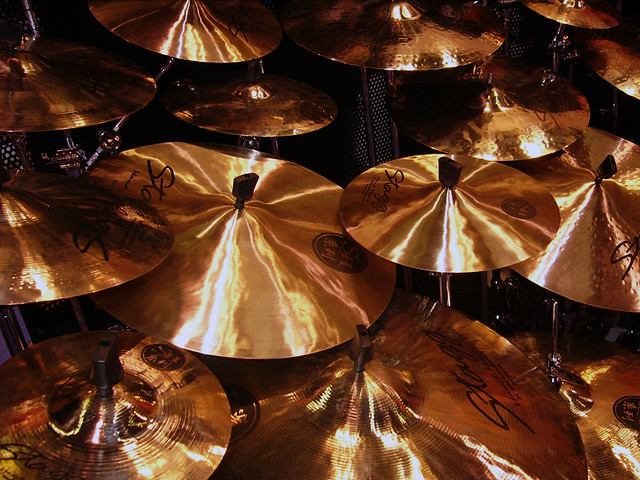When a percussion player is given a cymbal part, they may find themselves performing on a set of hand cymbals, rolling on a suspended cymbal, or jamming out a beat on a drum set. Different types of cymbals are used for each music situation. An extensive knowledge of the different cymbal types is necessary in order to better perform the music and avoid making a novice musician's mistakes.
A ride cymbal is most commonly seen in a drum set situation. A ride cymbal is usually slightly heavier than a crash cymbal. The percussion player plays the ride cymbal with a stick. A traditional use of the ride cymbal is the use of it in jazz ensembles, where the percussion player performs the characteristic "tap, tap-ta-tap, tap-ta-tap" rhythm often associated with more traditional jazz styles. The ride cymbal often keeps the beat and slight music accents, and should not be used for heavy cymbal crashes.
A crash cymbal is often thinner than the ride cymbal. Hand cymbals are two crash cymbals with cymbal straps held by the percussion player to strike the two cymbal plates together. The hand cymbals can come in a variety of sizes, metals, and weights. Which set of cymbals the percussion player will use depends entirely on the music being played and often budget restraints since a good set of hand cymbals can easily run over $300. In a drum set setting, the crash cymbal is suspended on a suspended cymbal stand and struck by the drumstick or brush being used by the drum set player.
Drum sets will often have several types and sizes of crash cymbals.
A sizzle cymbal sound can be duplicated by hanging a metal chain across the top end of the cymbal. If you purchase a sizzle cymbal it will most likely have holes drilled into it and tiny metal pieces in the holes. The sizzle cymbal is really only a special effects cymbal.
A splash cymbal is a very small and thin crash cymbal used most often for accenting music rhythms on a drum set.
High hat cymbals are a set of cymbals that are suspended on a high hat stand. The cymbals are placed edge to edge and a foot pedal allows the high hat cymbals to strike against each other. The heavier cymbal should be at the bottom. Though often similar to a ride cymbal in vibrations, the type of sound required by each high hat is mostly up to the taste of the drum set player.
Today there are also many different types of specialty cymbals for a variety of unique sounds. Cymbals will continue to evolve.
 |
| There are many different types of cymbals |
A ride cymbal is most commonly seen in a drum set situation. A ride cymbal is usually slightly heavier than a crash cymbal. The percussion player plays the ride cymbal with a stick. A traditional use of the ride cymbal is the use of it in jazz ensembles, where the percussion player performs the characteristic "tap, tap-ta-tap, tap-ta-tap" rhythm often associated with more traditional jazz styles. The ride cymbal often keeps the beat and slight music accents, and should not be used for heavy cymbal crashes.
A crash cymbal is often thinner than the ride cymbal. Hand cymbals are two crash cymbals with cymbal straps held by the percussion player to strike the two cymbal plates together. The hand cymbals can come in a variety of sizes, metals, and weights. Which set of cymbals the percussion player will use depends entirely on the music being played and often budget restraints since a good set of hand cymbals can easily run over $300. In a drum set setting, the crash cymbal is suspended on a suspended cymbal stand and struck by the drumstick or brush being used by the drum set player.
Drum sets will often have several types and sizes of crash cymbals.
A sizzle cymbal sound can be duplicated by hanging a metal chain across the top end of the cymbal. If you purchase a sizzle cymbal it will most likely have holes drilled into it and tiny metal pieces in the holes. The sizzle cymbal is really only a special effects cymbal.
A splash cymbal is a very small and thin crash cymbal used most often for accenting music rhythms on a drum set.
High hat cymbals are a set of cymbals that are suspended on a high hat stand. The cymbals are placed edge to edge and a foot pedal allows the high hat cymbals to strike against each other. The heavier cymbal should be at the bottom. Though often similar to a ride cymbal in vibrations, the type of sound required by each high hat is mostly up to the taste of the drum set player.
Today there are also many different types of specialty cymbals for a variety of unique sounds. Cymbals will continue to evolve.












Comments